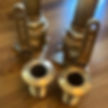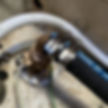How to select, remove, replace, and eliminate thru-hulls and seacocks - Part 1
Updated: Jun 9, 2020
Imagine putting a hole in the bottom of your boat - on purpose. Well, that's what it means to install, or remove, a thru-hull. It's no wonder experienced sailors and boaters of all stripes treat thru-hulls with reverence and avoid adding more of them, if possible. Regular inspection and maintenance of existing thru-hulls, especially those located below the waterline, should be a top priority. Thru-hulls, seacocks, and a bonding system are structural parts of your boat and, like everything else, these require regular inspection and maintenance. Don't neglect it or you'll regret it — a failed or frozen thru-hull can sink your boat!
In this four-part series, we’ll share our first-hand experiences and lessons learned to help you prepare to tackle the job, step by step, of selecting, removing, replacing, and even eliminating thru-hulls below the waterline. The good news is maintaining and replacing thru-hulls is a job any DIYer can tackle, as long as you do your homework and take the time to do the job properly. Let's start with the do's and don'ts of thru-hull selection and installation. We'll also take a look at common signs and problems which may indicate it's time to show your thru-hulls some love.
The do’s and don’ts of thru-hulls, seacocks, and bonding systems
Selecting and installing thru-hulls and seacocks
Do: Thru-hulls and seacocks installed below the waterline should either be high quality bronze, such as Groco or Perko, or an ABYC approved polymer, such as TrueDesign. The primary advantage of non-metalic thru-hulls and seacocks is their light weight and elimination of galvanic corrosion concerns. The downside, however, is non-metalic fittings have to be larger in size to achieve the required strength, so installations in tight spaces may not be feasible and parts more difficult to find.
Don't: Thru-hulls and seacocks should never be brass or plastic. Also, never mix the materials, for example: using a stainless thru-hull with a bronze seacock. The dissimilar metals will suffer from rapid galvanic corrosion. In this example, the seacock would become a sacrificial anode! High quality, solid cast bronze fittings are strong, simple to maintain, and resilient to harsh saltwater environments and worth the peace of mind. Oddly enough, some newer production boats come with brass thru-hulls installed. Take our advice: if you find brass thru-hulls on your boat, no matter how new, replaced them as soon as possible. They will corrode and fail within a few years.
Do: use seacocks that have a large flanged base, like the ones we installed below:

A wide flange base allows the seacock to be mounted securely with through bolts to a fiberglass or other synthetic backing block. The Groco backing block is a great choice though a number of options are available; you can also make your own out of G10. The backing block should be permanently bonded to the inside of the hull. Unlike plywood, synthetic backing blocks won't rot from inevitable sweating around the thru-hull, which results from the difference between the sea water and air temperature.
Don't: use straight ball-valves in place of a proper seacock below the waterline, because there is no good way to secure the valve to the hull and prevent it from turning. Also, winterizing and bonding are more challenging. In short, don't do it.
Do: use a non-permanent marine caulk/ sealant designed for use below the waterline and suited for thru-hull installation. Good choices include Boat Life - Life Caulk, Life Seal, or SikaFlex 291. These have all the bonding strength needed for the job but the seal can be broken without damaging the substrate Or requiring more extreme measures, like heat or an angle grinder.
Don't: use 5200. While some swear by 3M's 5200 Marine Sealant for its tenacious, reliable bond many others curse the use of 5200 as having no business anywhere near a boat, except perhaps a hull to deck joint, especially on parts that will eventually have to be replaced. While 5200 will do the job, it's a bit like firing a machine gun at a mosquito. Since there are less tenacious options perfectly suited to the task, we don't recommend using 5200.
Do: bond seacocks with wire, daisy-chain style, using green insulated, size 8 AWG tinned copper marine grade wire, per the ABYC standard. This is a controversial topic. Some think this is unnecessary, but I'll stick with the standard. The wire should terminate to an external zinc anode mounted below the waterline. Bonding helps protect thru-hulls from galvanic corrosion by equalizing the electrical current across the metal fittings below the waterline. You can read more here for additional information on various types of marine corrosion.

A properly installed Groco bronze seacock and backing block on "Koinonia."

A properly installed Groco bronze thru-hull with 1/4 inch or less of thread space inside the seacock and sealed with Boat Life - Life Caulk.
Seacock maintenance
Unless your boat lives on a trailer, the valves should be exercised on a regular schedule. Every other month or so is ideal. In cooler climates and fresh water, you can stretch this out a bit further to quarterly. The procedure is as simple as opening and closing each valve a few times to clear marine growth and lubricate the valve. They should turn with minimal effort, after exercising a few times. If you find you need to eat a can of spinach to get the valves to budge, consider increasing the frequency and check the last time the valves were greased. Bronze seacocks usually have one or two drains on the side which accept a zerk fitting. If it's been more than 12 months, follow the manufacturers instructions to top up the grease. If you buy new seacocks, grease them before you install; they don't come fully greased.
Signs you need to service or replace seacocks and thru-hulls
Let’s take a look at some of the tell-tale signs that indicate you need to take action. A seacock with a missing valve handle, a seacock that has become seized, excessive or rapid corrosion - all high-priority issues that need to be addressed.
If a seacock won’t turn, or is difficult to turn, it’s time to show them some love. The root cause could be something simple like excessive marine growth or something more serious like an errant electrical current causing rapid corrosion of the metal, which can happen at a surprisingly rate. If the valve is completely frozen, this a serious issue since you won't be able to close or open the valve in an emergency situation, like a hose failure. The ideal approach is to haul the boat out of the water and inspect the thru-hull inside and out. If this is not feasible and you must work with the boat in the water, exercise extreme caution and work in the daylight where you can see and be seen. Avoid using excessive force as you could damage or break the fitting and sink your boat!
The biggest thing to watch out for are changes that occur rapidly. Below are some examples of the most common problems you're likely to encounter:
Basic corrosion (aka old age)
These are images of an original thru-hull and seacock on "Koinonia." Due to their age (almost 40 years) we decided to inspect carefully. The thru-hull mushroom head (left) looks pretty good, but after sanding (middle), the color has started to turn to a pinkish/ copper color (see dezincification below). The green patina on the seacock (right), also called verdigris, is a natural phenomenon and isn't a problem. The issue was the seacock was frozen open, probably because the missing handle meant it was never exercised. If the hose or clamps failed, it could sink our boat!
Dezincification

This type of thru-hull corrosion is the result of the zinc being selectively removed from the bronze in the alkaline solution (saltwater), leaving behind a weakened deposit of porous, copper-rich metal. Notice the pink "spots" on the metal fitting. This is a good sign it's time to replace your thru-hulls and check your seacocks. This can be prevented with upkeep of your zinc anodes.
Galvanic corrosion

This type of marine corrosion can be slowed and largely mitigated with the use of proper bonding and upkeep of sacrificial anodes. It occurs anytime a metal surface is connected to a dissimilar metal while submersed in an electrolyte solution (salt water), which creates an electrical current between the two metals. If you keep your boat in a marina in a warm climate, your boat may be especially susceptible.
Electrolytic corrosion

Sometimes inaccurately referred to as "electrolysis," this is a serious type of marine corrosion that can occur suddenly and stems from a stray electrical current from an outside source, usually the boat's own electrical system or another boat nearby. The stray current is leached out through the water and causes accelerated corrosion. Stray 12v DC currents can often be identified from discolorations on and around the thru-hull. AC currents leached from shore power at a marina can corrode metal fittings below the waterline very rapidly, in a matter of days or even hours, and are a serious hazard to you and your boat. Never let a child or dog swim around boats in a marina.
Don't let all of this information overwhelm you. Thru-hull maintenance and installation is really very straightforward, but it's important to be proactive and know the signs to look out for and what these signs mean. Your boat is talking to you, but you have to pay attention and take action when it's called for.
In our next post, we'll look at how to remove old thru-hulls. Then, we’ll share how to properly install a new seacock and thru-hull. Finally, we'll cover how to eliminate a machined hole below the waterline, step by step, in case you have an opportunity to reduce the number of holes in the bottom of your boat!
We hope this post is helpful to you and we'd like to hear about your experiences, so please like and leave us a comment. We love to hear from you! Also, don't forget to hit share so you can help all your boating friends on social media.









